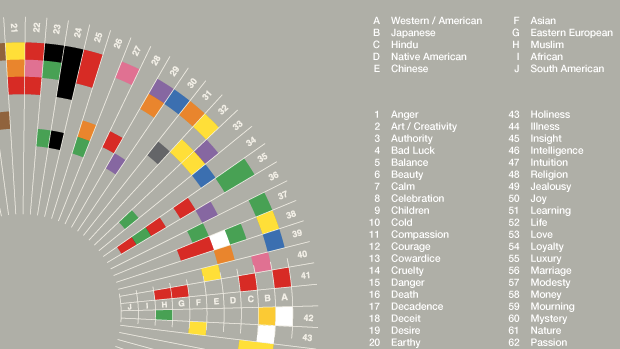Colors are probably the most obvious way that design varies across cultures (a theme that came up in our interview with Frog Design about designing for China). But the funny thing is that for most designers and companies, those color sensibilities often don't rise past "Red is lucky in China; blue is soothing in the West." That's naive, as this superb infographic by David McCandless and Always With Honor shows.
The chart
encompasses 10 different cultures, and 62 emotions (!!!). The cultures
are represented by concentric rings, and the emotions are represented by
slices of the circle. Thus, if you want to understand about Japanese
color sensibilities, you read around the graph. And if you want to learn
what colors mean "danger" across cultures, you just read vertically,
down section 15:


 Every social enterprise startup knows the drill: pitch + plan +
powerpoint = profit.
Every social enterprise startup knows the drill: pitch + plan +
powerpoint = profit.
 The IPO pipeline fattened considerably in the first quarter, especially among smaller companies, according to a quarterly report from Ernst & Young LLP.
The IPO pipeline fattened considerably in the first quarter, especially among smaller companies, according to a quarterly report from Ernst & Young LLP.
 Because
Because  hursday was a good PR day for the social buying site
hursday was a good PR day for the social buying site  Starting in the summer of 2009, Russian holding firm Digital Sky Technologies (DST) began taking huge stakes in successful American startups.
Starting in the summer of 2009, Russian holding firm Digital Sky Technologies (DST) began taking huge stakes in successful American startups. In
response to Google's recent
In
response to Google's recent  Welcome to our April Update on what’s new at Philadelphia Social Innovations Journal. In this update …
Welcome to our April Update on what’s new at Philadelphia Social Innovations Journal. In this update …



 The U.S. Commerce Department’s Economics and Statistics Administration released two new reports last week: one that defines and measures the size and scope of the green economy and another that looks at the ways in which the American economy's greenhouse gas emissions have changed over the past decade.
The U.S. Commerce Department’s Economics and Statistics Administration released two new reports last week: one that defines and measures the size and scope of the green economy and another that looks at the ways in which the American economy's greenhouse gas emissions have changed over the past decade.
 You know the value is there in social media, but despite your best efforts (or what you think are your best efforts), you’re still struggling to attract anyone. What’s going on and how can you change your social media luck? Below are six reasons SMBs often fail in social media and how you can turn it around.
You know the value is there in social media, but despite your best efforts (or what you think are your best efforts), you’re still struggling to attract anyone. What’s going on and how can you change your social media luck? Below are six reasons SMBs often fail in social media and how you can turn it around. For nearly four decades, Boy Scout merit badges have been awarded for the qualities, principles and virtues society most values in young people.
For nearly four decades, Boy Scout merit badges have been awarded for the qualities, principles and virtues society most values in young people. Ramping up customer satisfaction, maximizing the effectiveness of human capital and repairing supply chains were just a few of the ambitious aims of the ground-breaking "tools" entered in the inaugural Wipro/Knowledge@Wharton Innovation Tournament, whose final round of judging took place on March 23 in Philadelphia.
Ramping up customer satisfaction, maximizing the effectiveness of human capital and repairing supply chains were just a few of the ambitious aims of the ground-breaking "tools" entered in the inaugural Wipro/Knowledge@Wharton Innovation Tournament, whose final round of judging took place on March 23 in Philadelphia.